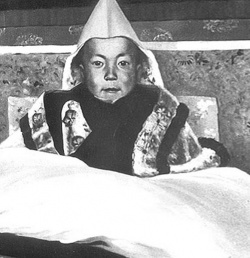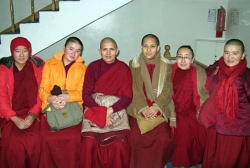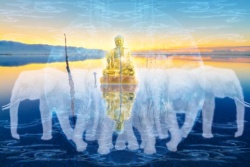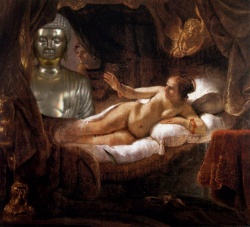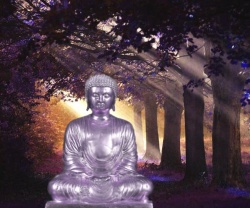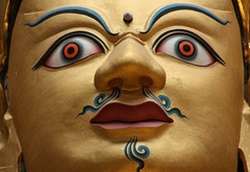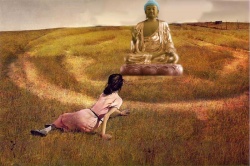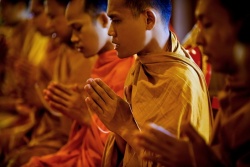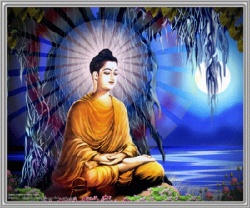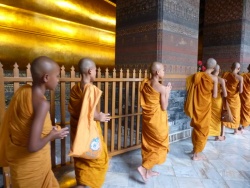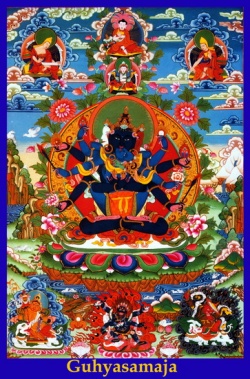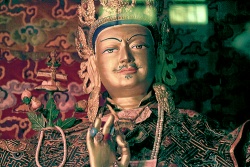Tulku
Click here to see other articles relating to word Tulku
In Tibetan Buddhism, a tulku (Tibetan: སྤྲུལ་སྐུ, Wylie: sprul sku, ZYPY: Zhügu, also tülku, trulku) is someone who is recognized as the rebirth of a previous practitioner.
High-profile examples include the Dalai Lamae Panchen Lama and the Karmapa. tulkus:
Tibetan term for great lamas who reincarnate to continue teaching their followers and who usually leave instructions on how find them in their new births.
Only the first person in a line of reincarnations is the actual "tulku," but the term is applied more broadly.
See also; "nirmanakaya" and “rinpoche.”
Tulku(Tib., corresponding to Skt. nirmanakaya). Literally, physical form or emanation of the Buddha. Also used to refer to Reincarnate Lamas (q.v.).
It has been estimated that as of 2012 there were about 500 tulkus across Tibet, although before the Chinese invasion there were probably a few thousand. Each tulku has a distinct lineage of rebirths.
For example, the Fourteenth Dalai Lama is held to be the reincarnation of each of the previous thirteen Dalai Lamas of Tibet, who are in turn considered to be manifestations of Avalokiteshvara, or Chenrezig, Bodhisattva of Compassion, holder of the White Lotus.
The vast majority of tulkus (and lamas) are men, although some are women.
The tulku incarnation lineage should not be confused with the lineage of Buddhist masters and their disciples, which is concerned with the oral or written transmission of particular Buddhist teachings and spiritual practice from generation to generation.
Nomenclature and etymology
The word སྤྲུལ or 'sprul' (Modern Lhasa Tibetan ʈʉlku was originally a verb in Old Tibetan literature, found at 敦煌/Dunhuang, and was used to describe the བཙན་པོ་ btsanpo ('emperor'/天子) taking a human form on earth.
So the 'sprul' idea of taking a corporeal form is a local religious idea alien to Indian Buddhism and other forms of Buddhism (e.g. Theravadin or Zen).
Over time, indigenous religious ideas became assimilated by the new Buddhism; e.g. 'sprul' became part of a compound noun, སྤྲུལ་སྐུ་'sprul.sku' ("incarnation body" or 'tülku', and 'btsan', the term for the imperial ruler of the Tibetan Empire, became a kind of mountain deity).
The term tülku became associated with the translation of the Sanskrit philosophical term nirmanakaya.
According to the philosophical system of trikaya or three bodies of Buddha, nirmanakaya is the Buddha's "body" in the sense of the body-mind (Sanskrit: nāmarūpa).
Thus, the person of Siddhartha Gautama, the historical Buddha, is an example of nirmanakaya.
In the context of Tibetan Buddhism, tülku is used to refer to the corporeal existence of enlightened Buddhist masters in general.
In addition to Tibetans and related peoples, Tibetan Buddhism is a traditional religion of the Mongols and their relatives.
The Mongolian word for a tulku is qubilγan, though such persons may also be called by the honorific title qutuγtu (Tib: 'phags-pa / Skt: ārya), or hutagt in the standard Khalkha dialect.
According to the Light of Fearless Indestructible Wisdom by Khenpo Tsewang Dongyal:
designates one who is "noble" (or "selfless" according to Buddha's usage) and used in Buddhist texts to denote a highly achieved being who has attained the first bhumi, a level of attainment which is truly egoless, or higher.
The Chinese word for tulku is huófó (活佛), which literally means "living Buddha" and is sometimes used to mean tulku although this is rare outside of Chinese sources.
Also, modern Chinese sources typically refer to a young incarnation of a (presumably male) tulku as a "soul boy" (Chinese: 靈童; pinyin: língtóng).
However, according to the Dalai Lamas are wrong. Tibetan Buddhism recognizes no such thing."
Also, in interviews that he has given, the Dalai Lama has frequently dismissed the notion of 'living Buddha' referring to it as "nonsense".
Characteristics
History
The Tibetan institution of the tulku as the emanation (often misunderstood as the rebirth) of a lama developed during the 12th, 13th, and 14th centuries, as various Schools of Tibetan Buddhism began to accept the possibility that exemplary figures might remain within the human world as institutional teachers, manifesting from one lifetime to the next out of compassion.
At this point, the notion of nirmanakaya, or created body of a Buddha, became linked to a notion of regular manifestation (Tibetan: yangsi, Wylie: yang-srid).
The most dramatic—and at that time controversial—innovation was the idea that a tulku could inherit the estate (Tibetan: labrang) of their previous incarnation.
This rule of inheritance allowed for the rise of hugely wealthy estates belonging to the lineages of reincarnating tulkus.
The first recognized tulku of this kind within the Vajrayana traditions was the Karmapa, the head of the Karma Kagyu school of Tibetan Buddhism;
precisely, the first to be recognized as a manifestation was the second Karmapa, Karma Pakshi (1204–1283). The Karmapa is now in his 17th emanation.
While most tulkus historically have been Tibetans, some have also been born among various other peoples with whom the Tibetans have had contact, such as the Mongols.
Now in the Tibetan diaspora, tulku are being found all over the world. In modern times, as Tibetan Buddhism has attracted followers across the world, a small number of tulkus have been found among Western people.
Perhaps the most religiously significant such tulku is Tenzin Ösel (born 1985), the child of Spanish parents, who has been recognized as the reincarnation of Thubten Yeshe, an influential Tibetan lama.
In 1988 a conference was convened at the request of the Dalai Lama at which approximately 350 tulkus and Abbots attended from all five Tibetan spiritual traditions - Nyingma, Sakya, Kagyu, Gelug, and Bon.
The agenda was to discuss the future of the Tibetan spiritual traditions in the Indian subcontinent, Tibet and foreign countries, and the relationship with science and foreign religions.
Finding a successor
As a tulku nears death he (or she) may hint in writings or reveal signs, to those with the karmic proclivity, that will help determine his or her successor or next mindstream emanation.
Sometimes, a tulku will leave a prediction letter or song describing where they will be found, sometimes adding various details about their future parents, the situation of their house and so on.
If such details are lacking, the monks whose duty is to locate his reincarnation, resort to a lama-tulku astrologer (or tsispa) for directions. Prophecies, which may date forward or backward many generations, also play a role.
The vetting of a potential successor often involves tests such as checking whether the child can recognize acquaintances or possessions from his previous life or answer questions only known to his former life-experience.
According to the book Magic and Mystery in Tibet by Alexandra David-Neel,
“A number of objects such as rosaries, ritualistic implements, books, tea-cups, etc., are placed together, and the child must pick out those that belonged to the late tulku, thus showing that he recognizes the things that were his in his previous life."
This process was portrayed in the movies Kundun and The Golden Child.
The thoroughness of the testing procedure varies according to the eminence of the tulku.
For minor figures, associated with a particular area or monastery only, the choice is sometimes made after a perfunctory search and often motivated by political considerations.
For major tulkus, like the Dalai Lamas and the Panchen Lamas, a great deal of care is taken to ensure the accuracy of the process of finding a successor.
Usually the tulku heir has been male, that is, appeared in male form.
However, discussing his own successor, the Dalai Lama has been quoted as saying that "if a woman reveals herself as more useful the lama could very well be reincarnated in this form".
The Dalai Lama has also said (when speculating about the possibility that his people might have no use for a Dalai Lama after he dies) that he "might take rebirth as an insect, or an animal...".
Tulku lineages
- See also:List of tulku lineages
Tibetologist Françoise Pommaret estimates there are presently approximately 500 tulku lineages found across Tibet, Bhutan, Northern India, Nepal, Mongolia, and the southwest provinces of China.
The vast majority of tulkus are men, although there are a small number of female tulku lineages.
The most prestigious female tulku lineage is that of the Dorje Phagmo of Samding Monastery.
By far the most politically powerful tulku lineage for the past several hundred years have been the Dalai Lamas, which has seen a total of fourteen emanations beginning with Gedun Drub.
Note that the title "Dalai Lama" was not applied to this line from the beginning: the second emanation was seen simply as the rebirth of Gedun Drub.
The same was true of the third emanation, Sonam Gyatso, until he was dubbed "Dalai Lama" as an adult, after which he applied the title posthumously to his predecessors and declared himself the 3rd Dalai Lama.
It was Lobsang Gyatso (1617–1682), the 5th Dalai Lama, who established the Dalai Lamas as Tibet's predominant political power.
After their control was consolidated, recognition of some of the most important tulkus was vetted by the government at Lhasa, and could on occasion be banned if its previous incumbent fell out of favor.
A notable example of this penalty was the Shamarpa, once the most powerful subordinate of the Karmapa, whose recognition of reincarnation was banned by order of the Dalai Lama in 1792.
This ban remained in place until after the Dalai Lama lost power in Tibet during the 1950s, although it was later revealed that the Karmapa had recognized emanations of the Shamarpa secretly during the intervening period.
Lineages of tulkus may be interlinked—for example the Panchen Lama traditionally recognizes the new incarnation of the Dalai Lama and vice versa.
In most cases there is no such relationship, but the potential candidate is always vetted by respected lamas (as described above).
Jetsunma Ahkon Lhamo is an enthroned tulku within the Palyul lineage of the Nyingma tradition recognized by Penor Rinpoche. In the late 1980s, she gained international attention as the first Western woman to be named a reincarnate lama.
Controversy and Criticisms
The recognition of tulkus has sometimes involved ambiguity as well as controversy. According to Tibetan historian Samten Gyaltsen Karmay, Lobsang Gyatso, the 5th Dalai Lama, wrote in his autobiography:
- The official Tsawa Kachu of the Ganden Palace showed me statues and rosaries (that belonged to the Fourth Dalai Lama and other lamas), but I was unable to distinguish between them!
When he left the room I heard him tell the people outside that I had successfully passed the tests.
Later, when he became my tutor, he would often admonish me and say: "You must work hard, since you were unable to recognize the objects!"
In the 2009 documentary film Tulku, Dzongsar Jamyang Khyentse Rinpoche argues against the institutionalized Tulku system stating,
- And now, I personally think that to hold that culture, institutionalized Tulku. That culture is dying; it’s not going to work anymore. And even if it…
And if it doesn’t work, I think it’s almost for the better because this tulku, it’s going to… If the Tibetans are not careful, this Tulku system is going to ruin Buddhism.
At the end of the day Buddhism is more important [than] Tulku system, who cares about Tulku... [and] what happens to them.
The American film actor Steven Seagal, while already an adult, was recognized by Penor Rinpoche, the head of the Nyingma school, as the reincarnation of a 17th century tertön from eastern Tibet, Chungdrag Dorje.
Penor Rinpoche notes that "such recognition does not mean that one is already a realized teacher"; Seagal has not been enthroned and has not undergone the extensive program of training and study that is customary for a tulku.
Osel Hita Torres is a Tibetan Buddhist tulku and aspiring cinematographer from Spain.
Hita was designated soon after his birth as the reincarnation of Lama Thubten Yeshe—making him one of only a handful of Western tulkus—and renamed Tenzin Ösel Rinpoche.
For many years "Lama Ösel" was expected to succeed to leadership of the Foundation for the Preservation of the Mahayana Tradition (FPMT), the organization co-founded by Yeshe.
As a university student, however, "Oz" (as he is now known) gradually distanced himself from the FPMT, and in 2009 made media statements clarifying his intention to pursue a life independent of that organization.
A documentary about Hita's life, called The Reluctant Lama, was broadcast on BBC Radio 4 on 28th September 2012.
Documentaries
In popular culture
- In the 1994 film The Shadow, a mystical tulku trains Lamont Cranston to use his inner darkness to fight crime.
- In the book Tulku, by Peter Dickinson, a young boy and his companions, fleeing the Boxer Rebellion in China, encounter Tibetan monks awaiting the birth of a tulku.
